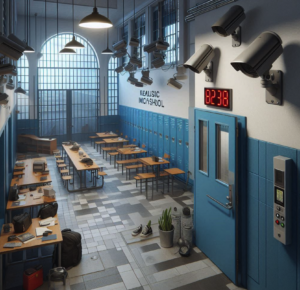Are you a superintendent, school board member, or principal who does not want to be blindsided by school security mandates, financial burdens, and potential liability? If so, you will want to learn about a new maneuver, largely driven and influenced by security consultants and vendors, to create a “school security standard” that has potentially significant implications and consequences for school leaders.
ASIS International, founded in1955 as the American Society for Industrial Security, is a global security industry membership organization. It provides training, certification, publications, and events. The association’s website also states that, “ASIS plays a pivotal role to influence and impact security standards worldwide.”
ASIS “K-12” School Security Standard

ASIS has had a committee on school security for decades. Over the past two years, a technical committee was formed to create what ASIS describes the first school security standard. In a recent Security Industry Association (SIA) webinar to introduce the draft standard, it was further described as an “international” standard.
ASIS states on its website the following description of its school security standard:
“The Standard provides requirements and guidance for the development, implementation, maintenance, and continual improvement of a school security program. It addresses assessing risk and developing protective strategies (utilizing physical security principles) for applying physical security measures necessary to support and promote safe educational environments (K-12). The Standard provides a basis for responsible parties to develop policies, plans, procedures, controls, and integrated physical security systems to achieve a comprehensive school security program. While the response to incidents is a part of a holistic security program, this standard focuses on preventing security‐related incidents.”
ASIS is accredited by the American National Standards Institute (ANSI) and is working to establish the ASIS School Security Standard as an ANSI recognized “consensus standard.”
The first public review and comment section is closed. The technical committee will hold meetings in October, November, and December 2024 to “adjudicate comments from the 3rd committee review and ANSI public review process” according to the ASIS website. The goal is for the standard to be finalized in the second half of 2025.
ASIS School Security Standard impressions, omissions, deficiencies, and implications
The first draft of the ASIS School Security Standard was released for public review from July 26 to September 9, 2024. The Security Industry Association (SIA) held a brief webinar to introduce the ASIS standard on August 22, 2024. A press conference with presentations by five individuals associated with creation of the standard was held at the ASIS GSX conference on September 24, 2024, which was recorded and posted on the ASIS website.
Initial observations and implications include, but are not limited to:
The draft of ASIS School Security Standard was behind a paywall and required a payment of $50 to obtain a copy of the draft for review to provide comments as part of their “consensus” process. One would expect that if feedback and consensus were truly desired, the ASIS draft standard would not be buried behind a paywall with a fee required to access it for review to provide feedback for consensus development. Doing so certainly is not consistent with its claim of an “open” and balanced process. It also limits access to those without the financial resources to access the document, especially the educators upon whom this standard is going to be imposed.
At the September 24th press conference, an audience member relayed similar concerns from multiple persons about having to pay to access the draft. Committee Co-Chair Drew Neckar indicated he also had received some comments. However, no commitment was made by ASIS to make the document accessible without a fee for subsequent reviews.
The draft of the standard contains language indicating the material at some future date will be included in copyrighted material by ASIS International and may not be reproduced, stored or transmitted in any form. This suggests a proprietary (and likely financial) interest in this standard being developed by ASIS.
The draft comment period was opened at a time when educators who, if they were to have even known about the draft standard, would be too consumed with school opening to discover, review, and comment on the draft standard. The draft comment period was opened in late July through early September, a time when most PreK-12 educators are returning to school from summer breaks, attending professional development and back-to-school meetings, and preparing to open schools for students.
The draft standard had a glaring omission of the names of its committee members and volunteers who created the draft. It would be expected that a standard with national implications would list the names and organizational affiliations of its committee members and volunteers who created the draft for transparency purposes. In the press conference, a speaker indicated that 50 people participated in the creation of the standard. However, aside from a space for the standard abstract, the sections for these names were the only omitted information in the standard document.
Based upon information shared online and in the September 24 press conference, there appears to be a heavy imbalance of representatives from outside the PreK-12 education community in developing the standard. There was a glaring absence of reference to the national education professional associations representing school boards, superintendents, and principals. At the ASIS press conference, however, it was disclosed by the committee co-chair that the federal government is involved in creating this standard, which raises numerous questions.
Credentialed and credible contributors from other security industries, but a glaring absence of national associations representing school leaders: Co-Chair Drew Neckar indicated that while the 50 people involved in creating the standard included some with education experience and school security directors, it also included representatives from federal agencies, architects, state government and state boards of education, academicians, school resource officers, police officers, and consultants. The ASIS website also lists contributors as facilities management, life safety, law enforcement, business continuity, and legal backgrounds as well.
It was notable that of five presenters at the September 24th ASIS press conference, only one speaker had full-time PreK-12 education experience as a schoolteacher and administrator, and then later as a state school safety specialist. He acknowledged that schools are extremely unique settings compared to other settings. Yet so many developers of this standard appear to be from outside of the PreK-12 education community.
While there are unquestionably highly credentialed and credible security professionals serving industries outside of the PreK-12 school community involved in the standard development process, the glaring absence of national professional associations for education leaders is sorely noted. There was no presence or discussion of representatives from national associations representing school boards, superintendents, and principals — the people who would be operationally, financially, and legally responsible for implementing the standard and overall school safety programs.
Not organically grown, but externally imposed? This does not appear to be a process organically grown from within the PreK-12 education community, but instead one that was initiated and driven largely by security consultants, vendor-affiliated individuals, and others outside of the PreK-12 education community. This creates the appearance of a standard being created by individuals from outside of the PreK-12 education community, dictating requirement to be imposed upon the PreK-12 education community, and with potentially significant financial and legal implications for the PreK-12 education community.
Meaningful and credible standards must be created with the full participation of stakeholders within the given professional community for which the standards are being created, not imposed upon a professional community by individuals or associations outside of the targeted professional community. It is worth noting that if most school board members, superintendents, and principals in the United States were asked what “ASIS” stands for or what the association does, they would have no idea.
This says a lot about the relevance of ASIS to the PreK-12 school community. It also says a lot about the credibility of ASIS International trying to create and impose a standard of school security mandates upon the PreK-12 school community. While the intentions and passion of those volunteering to create the standard are not in question and are applauded, the disconnect between ASIS as an organization and the PreK-12 education community upon which it wishes to impose its standard is substantial and begs questions as to how an ASIS created standard can be viewed as valid.
Is the federal government now co-creating a federally supported first national school security standard? Co-Chair Drew Neckar noted in the press conference that federal agencies have been involved with the development of this school security standard. This raises significant questions and implications. Is the federal government now sanctioning (directly or indirectly through its participation) a national school security standard? If so, what are the potential future regulatory and legal implications of federal involvement in creation of a school security standard by a private organization (ASIS)?
A glaring omission: Did someone forget the “PreK” early childhood students when creating this standard? It is notable that the ASIS school security standard refers to K-12 environments. Experienced school security professionals recognize that many, if not most, school districts have PreK programs with early childhood students and, in some cases even infants, on campuses. The fact that the ASIS School Security Standard committee overlooked the PreK population and instead referred to the standard as “K-12” schools is a glaring omission and reinforces concerns about the imbalance of perspectives and depth in understanding PreK-12 schools when developing the standard.
 A skewed emphasis on “physical security”: Security hardware, products, and technology galore: The ASIS School Security Standard physical security main section is approximately 34 pages in length — more than twice the number of pages allocated for threat assessment and emergency operations sections combined. ASIS’ own description of its school security standard (listed above in this article) repeatedly references “physical security” related protective measures in its one-paragraph description.
A skewed emphasis on “physical security”: Security hardware, products, and technology galore: The ASIS School Security Standard physical security main section is approximately 34 pages in length — more than twice the number of pages allocated for threat assessment and emergency operations sections combined. ASIS’ own description of its school security standard (listed above in this article) repeatedly references “physical security” related protective measures in its one-paragraph description.
It was also noted that in the Security Industry Association (SIA) webinar, the threat assessment and emergency operations component of the ASIS standard got only one passing reference while the bulk of the webinar focused on physical security measures. These and other observations suggest this standard is heavily imbalanced with a focus on security hardware, products, and technology — a potentially substantial benefit for security vendors.
No evidence-based research of effectiveness of heavy physical security measures in schools: At the onset of the ASIS press conference, the co-chair of the ASIS School Security Standard committee stated that the standard is research-based. However, existing research specific to the effectiveness and impact of physical security/target hardening in PreK-12 schools does not support a heavy emphasis on physical security measures. A 2016 research report by Johns Hopkins University and 2024 best practices report by the International Association of Professional Security Consultants (IAPSC) found, at best, mixed results on the effectiveness of many physical security measures deployed in PreK-12 schools. Emerging academic research also indicates that in schools with a heavy presence of physical security measures, students had a decreased perception of school safety.
Research does, however, point to the best practices of taking a comprehensive school safety program approach. Recent political and financial profit influences, however, have shifted conversations to heavy target-hardening with security products, hardware, and technology. Sprinkling threat assessment and emergency operations in with a predominantly physical security standard is not comprehensive. “Comprehensive school safety,” while long being a research based best practice, has gotten lost in the war of school safety politics and vendor profit schemes.
Redundancy and potential liability risks: School safety research, literature, guides, manuals, checklists, state and federal school safety technical assistance centers, school safety government websites, etc. are readily available with best practices and support for school leaders on what to do and how to do it.
It was shocking to see the ASIS press conference present on threat assessment in schools when the nation’s premier researcher and creator of the CSTAG school threat assessment model, Dr. Dewey Cornell, was not on the panel to address the threat assessment component of the ASIS standard. Dr. Cornell had presented a session at the ASIS conference on threat assessment. His PreK-12 schools threat assessment model is widely respected and adopted nationwide, and serves as a perfect example of why the duplication of threat assessment in the ASIS standard is unnecessary given Dr. Cornell’s model stands alone as intensely research-based and evaluated.
ASIS standard Co-Chair Drew Neckar said in the press conference that the ASIS standard will be voluntary. He said that nobody will be forced to do it and referred to it as a toolkit. He also said the standard is a start of a comprehensive framework.
But comprehensive PreK-12 school safety frameworks have been well researched, evaluated, and in existence in the school safety field. Is ASIS – an organization unrecognized by most professionals in PreK-12 education – going to try to reinvent the wheel?
The ASIS standard is loaded with “shall” statements which implies that school “must” do XYZ rather than they “should” do it, which is often considered to offer more discretion as to whether or not to implement something. Contributors to the standard have said there was much debate — and disagreement – over the use of “shalls” when writing the ASIS standard. Critics say that ASIS would have been better off to represent their recommendations as a toolkit of recommended best practices, not “shall” mandates.
During the ASIS press conference, an audience member asked about accountability and noted that lawyers will use the ASIS School Security standard to go after school districts legally. His argument is likely correct. The most likely user of the ASIS School Security standard will not be educators. It will be plaintiff attorneys who file school safety lawsuits against schools and dangle the ASIS School Security Standard in arguments that schools were negligent by not following all of its “shall” mandates. While the ASIS standard will support the businesses of attorneys and expert witnesses, it is questionable as to whether it will have value to superintendents, school boards, principals, and other school leaders.
While the facts and merits of each case varies, liability claims in school safety cases typically focus on claims of alleged failures of human factors, not alleged failures of physical security. Yet the ASIS School Security standard is dominated by recommendations leading to physical security (security hardware, products, and technology) requirements. A skewed focus on physical security in the ASIS standard will likely most benefit security vendors and attorneys.
“If you have seen one school, you have seen one school.” Schools are unique from other industries. They also vary school-to-school and community-to-community. School safety policies and funding typically rest in the hands of elected local school boards and their school administrators – not international associations outside of the PreK-12 education community.
School safety decisions are made by local school leaders in concert with the members of their school community. A template or checklist from an international security association is not the guiding determining factor in these local decisions. Schools vary internationally, nationally, by state, by county, and even within the same school district. Cultural considerations, impoverished school community considerations, school size (one school, independent schools, charter schools, urban vs. rural, etc. etc.) all come into play.
The reality is that not every school will have a dedicated school security director as desired by some vendor-driven associations. They will also not have the budgets, manpower, time, and other elements need to meet the burden of implementing the ASIS School Security Standard.

The real agenda: A battle of security vendors for money? Use of the ASIS School Security Standard for lobbyists to take to state legislators and federal officials to codify elements of the standard into state and federal laws to mandate upon local school leaders?
Federal and state legislators should be on the alert for the ASIS standard to be used by security vendors and lobbyists to influence government laws and funding decisions. Lobbyists are already increasingly targeting state legislators and Congress. The ASIS School Security standard will likely be a tool for use in further lobbying and mandates.
In conclusion (for now)…
Do the PreK-12 school security directors, state education agency officials, and other educators contributing to the ASIS standard “walk the walk” of this standard in their own schools? It will be interesting to see how many PreK-12 school security directors and educators involved in the creation of the ASIS standard, or signing on in support of it, are actually compliant with it in their own schools/school districts. If they are not currently compliant, will they commit to staffing and funding to become compliant? Likewise, will their superintendents, principals, and school boards support and endorse the mandates that come with the standard, and sign-on to it now?
Imbalanced, redundant, and unnecessary: The ASIS School Security Standard is imbalanced, would pose unrealistic administrative and financial burdens upon schools, and would likely serve to raise liability claims in school security civil litigation.
Research, literature, guides, manuals, checklists, state and federal school safety technical assistance centers, school safety government websites, etc. are readily available with best practices. Educators do not need another template, checklist, toolkit, or hundred-page document filled with “shall” mandates. The ASIS standard just adds to the noise —but this noise has potentially heavy financial and litigation burdens.

